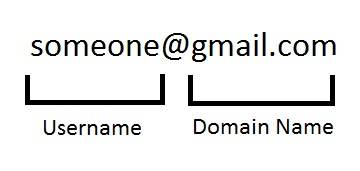Email is now a mature and commonplace part of modern life. But have you ever really learned the in’s and out’s of email?
Email is the electronic equal of regular mail with essential features that create a richer experience. Such as attaching files or photos. It can be sent directly as a carbon copy or as a blind carbon copy. Messages can be accessed from web browsers, from your phone, or by using an email client.
Let’s unpack the basics of email, so you have the foundation to use email fully and with confidence.
The Email Address
First, let’s break down the anatomy of the email address. An email address is a unique address that allows the user (you) to send or receive email messages. It’s also the destination address for the person you’re sending email messages to.
The first section of an email address is the username. The username is specific to the person you’re sending messages to. Their company may assign it, or they may have selected it for their email address.
The second part is the domain name. This name points to the computer or system of computers that manage and host their emails. These are called email servers.
The “@” symbol separates the username and the domain name. The software needs this to know when the username ends, and the domain name begins, but it has the added benefit of being readable.

Often companies host their email servers or set up a custom email server based on the same name as their website address. It’s also possible to sign up with an email provider to give you an address using their domain name. Examples of this include outlook.com, gmail.com, or apple.com.
The email functions the same regardless of what approach you use, but it’s very professional to have an email domain name that matches your website domain.
Properly Addressing Your Email
Email lets users access a very flexible addressing system leveraging the electronic format to provide effective communication options. The basic sections include the “To:”, “CC:”, and “BCC:” address boxes. Each one has some special feature that adds to the email experience, so taking a moment to learn them can step up your email game.

The “To:” address box is where you place the primary recipient’s address or multiple addresses if you have more than one recipient. By adding recipient addresses to this address box, you’re communicating that these people are the direct audience.
Users can add as many recipients as they like as long as they’re separated by a semi-colon followed by a space and the next email address. In most cases, your email software will add the proper separators when you add the addresses and press enter.
The “CC:” or carbon copy address box is for people who may not be the direct audience, but you want them to know that the email was sent. They can see everyone to whom the email was sent and all of the message’s details. They can directly reply to everyone and participate in the discussion if they like but typically will only be expected to observe the conversation.
The “BCC:” or blind carbon copy address box is for recipients you wish not to know who else was sent the message. They will see the email’s entire contents and the sender’s name, but they won’t see who else received the message.
They can be the primary audience, but perhaps you don’t want them to have each other’s email addresses. This address box is also used when the recipient list is extensive. If you have many recipients, it can clutter the email header making it confusing and awkward. Using the BCC address box cleans things up and looks more professional.
Writing or Composing an Email
Writing the body of the message you’re sending is a personal endeavor based on the original motivation to write it. However, writing an email is often a little less formal than the letter-writing format you were likely taught. There’s nothing wrong with borrowing from that, but here are a few examples.
Instead of using “Dear recipient,” people use something different like “Hello recipient,” “Hi recipient,” or “Hey recipient,” In some cases, it may make sense not to include the recipient’s name as well. Email lets you address a group, so it may be appropriate to open with, “Hello everyone,” “Hello All,” or “All,”
Personalize it with a group name if that’s relevant. (“Hello Grizzlies,”) There are even cases where people may message you back quickly, which is more like a conversation. In those cases, it’s appropriate to leave the opener off altogether.
Closing the email is also less formal. I don’t think I’ve ever seen an email closed with, “Yours truly,” To do so seems out of place. A more common close is something like “Regards,” “Thanks,” or “Later,” In certain situations, a short phrase may be appropriate.
Examples of closing phrases include “See you then,” “Thanks for your help,” or “Have a great day,” Don’t feel boxed into these examples. It’s entirely acceptable to improvise them.
Custom signatures are a nice touch that lets you save some time or even promote yourself. If you’ve gotten an email from the government or businesses, then you’ve likely seen these, but anyone can have one.
Find the signatures tab or button in your email client and create yours today. You can have more than one line, add small images and relevant links. You can add your signature manually or automatically, depending on the settings you choose. I find it handy even on my personal email since it saves typing on each message.
Email Attachments
Attachments deserve their own section. An email attachment is a file or photo added to your email to be sent to the recipient. This small innovation has changed the way information is exchanged throughout our lives. In the past, we would have to send printed copies from point to point.
This isn’t so bad, and it’s still necessary in some cases, like with significant signed contracts. Although, even that seems to be disappearing with the advent of digital signatures. However, physical copies are no match for the speed and flexibility of electronic copies.
Photos attached can be sent as an attached file or as an inserted photo that shows up in the reading pane. If sent as an attached file, it shows up in the list of attachments like any other file. However, if you insert it into the reading pane, the image shows in the email body with your text.
Sometimes it’s helpful to have an image mixed in with your text but be careful it doesn’t crowd out your message. Inserted images can be resized by hovering over a corner with your mouse and then clicking and dragging the corner in until you get the size you need.
Attachment size needs to be considered. Most inboxes have limits on how large the sum of all attachments can be on a single email. Email inboxes also have limits on how much information can be held, which includes attachments. A rule of thumb is to keep your total attachments under 10Mb.
I’ve seen cases where up to 30Mb is becoming more common, but you will have to test it out. If you notice that an email with large attachments is not getting successfully sent, it could be that the attachments are too large for your or their message size limit or that their inbox is full.
Sending an Email
Once you’ve got your addresses in place, your message has been crafted, and you’ve added the attachments, you can go ahead and click send. Provided everything was done correctly, the email should be promptly delivered.
Sometimes there can be a delay of a moment or two while the message is transferred. If you have large attachments, expect more significant delays. However, provided there weren’t any limits exceeded or address errors, it should arrive as intended.
Accessing Your Email
There are several ways you can access your email. One of my favorites is to set up the email client on my phone to receive and send an email. However, some email providers insist on using their app, which will manage your email hosted by them.
Either way, having your email on your phone can be helpful. Email today is typically written to accommodate phone users, so you won’t have trouble using a small screen to read an email.
The more traditional approach is through email software on your computer. These are still widely used. They can manage multiple email addresses and stack functionality onto email by including meetings, appointments, and reminders into a calendar.
Synchronizing this calendar with your mobile device is a critical part of staying up to date on your schedule. Your notifications will appear in both places, ensuring you don’t miss anything.
If you don’t have access to your mobile device or your computer, you can always access your email from another device through a browser. Most email providers support this option.
The look and feel are a bit different, but otherwise, it works just the same. Some people prefer this method of access for its flexibility. However, it does have the drawback that you need to log in every time you check your email.
However, you set up and use your email, make sure it works well for you. It should make your life easier, not harder.
